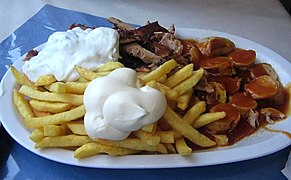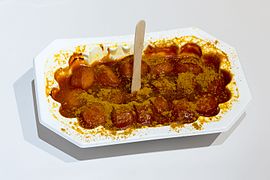food.wikisort.org - Dish
Currywurst (German: [ˈkœʁiˌvʊɐ̯st] (![]() listen)[1]) is a fast food dish of German origin consisting of steamed, fried sausage, usually pork (German: Bratwurst), typically cut into bite-sized chunks and seasoned with curry ketchup, a sauce based on spiced ketchup or tomato paste topped with curry powder, or a ready-made ketchup seasoned with curry and other spices. The dish is often served with fries.
listen)[1]) is a fast food dish of German origin consisting of steamed, fried sausage, usually pork (German: Bratwurst), typically cut into bite-sized chunks and seasoned with curry ketchup, a sauce based on spiced ketchup or tomato paste topped with curry powder, or a ready-made ketchup seasoned with curry and other spices. The dish is often served with fries.
This article uses bare URLs, which are uninformative and vulnerable to link rot. (August 2022) |
 Currywurst lightly topped with curry and served with French fries | |
| Type | Bratwurst |
|---|---|
| Place of origin | Germany |
| Created by | Herta Heuwer |
| Invented | 1949 |
| Serving temperature | Hot |
| Main ingredients | Pork sausage, curry ketchup |
History

The invention of currywurst is attributed to Herta Heuwer in Berlin in 1949, after she obtained ketchup (or possibly Worcestershire sauce) and curry powder from British soldiers in Germany.[2] She mixed these ingredients with other spices and poured it over grilled pork sausage. Heuwer started selling the cheap but filling snack at a street stand in the Charlottenburg district of Berlin, where it became popular with construction workers rebuilding the devastated city. She patented her sauce under the name "Chillup" in 1951.[3] At its height the stand was selling 10,000 servings per week.[4] She later opened a small restaurant which operated until 1974.[5] On 30 June 2013 Heuwer's 100th birthday was celebrated with a Google Doodle.[6]

Today, currywurst is often sold as a take-out/take-away food, Schnellimbisse (snack stands), at diners or "greasy spoons," on children's menus in restaurants, or as a street food and usually served with french fries or bread rolls (Brötchen). It is popular all over Germany but especially in the metropolitan areas of Berlin, Hamburg and the Ruhr Area. Considerable variation, both in the type of sausage used and the ingredients of the sauce, occurs between these areas. Common variations include the addition of paprika or chopped onions; halal food stands often prepare currywurst with beef sausage.[7] Often currywurst is sold in food booths, sometimes using a special machine to slice it into pieces, and served on a paper plate with a little wooden or plastic fork, mostly a Currywurst fork.[8] It is also sold as a supermarket-shelf product to prepare at home.[citation needed]
The Deutsches Currywurst Museum estimated that 800 million currywursts are eaten every year in Germany, with 70 million in Berlin alone.[9][10][11] The Volkswagen plant at Wolfsburg runs its own butchery producing about 7 million Volkswagen currywursts per year, serving many directly to Volkswagen employees.[12][13]
In popular culture
This article appears to contain trivial, minor, or unrelated references to popular culture. (October 2017) |
The currywurst is an icon of German popular culture. Former Chancellor Gerhard Schröder is a noted fan of currywurst.[14] By tradition, every candidate for the mayor of Berlin is photographed at a currywurst stand.[15]
The song "Currywurst" on Herbert Grönemeyer's 1982 album Total Egal is a tribute to the snack.[16]
The 1993 novel Die Entdeckung der Currywurst (English title: "The Invention of Curried Sausage", ISBN 978-0811212977) by Uwe Timm was made into a 1998 play and a 2008 film both of the same name. The plot is based on an alternative but unproven theory that currywurst was invented in Hamburg.
The Deutsches Currywurst Museum opened in Berlin on 15 August 2009, commemorating the 60th anniversary of its creation.[4][11] Curator Martin Loewer said "No other national German dish inspires so much history and has so many well-known fans".[17] The museum received approximately 350,000 visitors annually. It permanently closed on 21 December 2018.[18]
In 2019 Berlin State Mint issued a commemorative currywurst coin celebrating the 70 years since the savoury snack was first sold in Berlin by Herta Heuwer. The silver alloy coin features two currywursts pierced with a wooden chip fork and poured with the sauce (coloured by print), and Herta Heuwer in the background (caption: 70 Jahre Currywurst). The other side of the coin shows the Brandenburg Gate (caption: Münze Berlin, 2019).[19][20]
- Served with bread
- Currywurst - served sliced
- A "Taxi Teller" is a plate of fries served with currywurst, shashlik sauce, mayonnaise, gyros meat, and tzatsiki
- Currywurst as a supermarket-shelf product to prepare at home
See also
- German cuisine
- List of sausage dishes
- Salchipapa
References
- Duden, Curry. Accessed 2013-06-30
- Slackman, Michael (26 January 2011). "A Favorite Dish Laden With Fat and Contradiction". The New York Times. Retrieved 24 October 2020.
- Paterson, Tony (15 August 2009). "Spicy sausage that is worthy of a shrine in Berlin". The Independent. London. Retrieved 30 April 2010.
- "Honoring the best of the Wurst of German Cuisine". Deutsche Welle. 15 August 2009.
- Kessler, Roman (27 August 2009). "The Craze Over Currywurst". The Wall Street Journal.
- "Herta Heuwer's 100th Birthday". www.google.com.
- "Berlin 24/7: What's the currywurst cult all about? | DW | 03.09.2017". DW.COM.
- "A Food Lover's Guide to Berlin". Condé Nast. 12 November 2014. Retrieved 9 January 2015.
- Horenburg, Berit (23 August 2002). "Hau wech". Motorrad. Archived from the original on 30 October 2013. Retrieved 23 October 2013.
- "Data and Facts" (PDF) (Press release). Deutsches Currywurst Museum. September 2013. Archived from the original (PDF) on 29 October 2013. Retrieved 23 October 2013.
- "10 Things We Learned at Berlin's Museum Dedicated to Currywurst". Condé Nast. 17 December 2014. Retrieved 9 January 2015.
- Radomsky, Stephan (19 February 2016). "VW verkauft mehr Würste als Autos (VW sells more sausages than cars)".
- "Die Currywurst – das Originalteil wird 45! - Volkswagen inside". Archived from the original on 3 September 2018. Retrieved 3 September 2018.
- "Sausage Museum Celebrates Berliners' Romance With Currywurst". Bloomberg. 13 August 2009.
- Boyes, Roger (15 August 2009). "Berlin dedicates museum to street-corner snack of wurst cuisine". London: Times Online. Retrieved 30 April 2010.
- Grönemeyer, Herbert. "Currywurst" (in German). groenemeyer.de. Archived from the original on 6 January 2013. Retrieved 26 November 2009.
- "German cult sausage gets own museum". Reuters. 13 August 2009.
- http://currywurstmuseum.com/permanently-closed.html
- "A German mint has made a currywurst coin and online reaction has been mixed". Irish Independent. 15 January 2019.
- "70 Jahre Currywurst - Staatliche Münze Berlin" (in German). Staatliche Münze Berlin. Archived from the original on 14 January 2019. Retrieved 28 February 2019.
Further reading
- Connelly, Michael Alan (18 December 2014). "20 Must-Try Street Foods Around the World". Fodor's. Retrieved 24 July 2016.
External links
- Deutsches Currywurst Museum Berlin
- Berlin's obsession with currywurst - BBC News report
- Trying to perfect the recipe at home for BAOR veterans
- Currywurst is The Secret Weapon - AEG Perfunkt video about a West Berlin cult snack shop
- NY Times Jan 26, 2011 - National Dish Comes Wrapped in Foreign Flavoring
На других языках
- [en] Currywurst
[es] Currywurst
El Currywurst es una salchicha alemana cocida (Brühwurst) o asada a la parrilla (Bratwurst). La mayoría de las veces se sirve cortada en rebanadas y va acompañada de salsa kétchup o salsa de tomate y curry en polvo. El acompañamiento de esta salchicha suelen ser unos panecillos típicos alemanes (Brötchen) o unas simples patatas fritas. Se trata de una salchicha muy popular, pudiendo encontrarse en casi toda Alemania. Es muy habitual en los puestos callejeros (Imbiss), en los mercados y las ferias. En este tipo de establecimientos, se sirve todo en bandejas de cartón blanco con un tenedor para currywurst, muy adecuado para ir comiendo por la calle. En estos puestos, se encuentran los depósitos con salsa de tomate o kétchup para que cada comensal pueda añadir él mismo la cantidad que desee.[ru] Карривурст
Ка́рривурст (нем. Currywurst — «колбаса с карри») — немецкая культовая закуска из обжаренной и порезанной на кусочки сосиски под томатным соусом с карри. Карривурст традиционно относят к берлинской кухне: появившись во времена послевоенного дефицита, он впитал в себя историю города, разрушенного Второй мировой и разделённого холодной[1]. В 2009—2018 годах в Берлине неподалёку от исторического чекпойнта «Чарли» работал Музей карривурста[2]. Признанный немецкий национальный фастфуд[3] с международной славой в 2019 году отметил своё 70-летие, проложив себе за это время дорогу из пролетарских уличных закусочных на благородные фуршеты с белым фарфором и переживает «хипстерское возрождение» как веганская колбаска из сейтана или слоуфуд из регионального биомяса[4].Другой контент может иметь иную лицензию. Перед использованием материалов сайта WikiSort.org внимательно изучите правила лицензирования конкретных элементов наполнения сайта.
WikiSort.org - проект по пересортировке и дополнению контента Википедии




